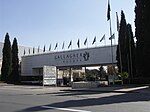Nizamiye Mosque
2012 establishments in South Africa21st-century mosques21st-century religious buildings and structures in South AfricaInfobox religious building with unknown affiliationIslamic schools in Africa ... and 6 more
Mosques completed in 2012Mosques in South AfricaReligious buildings and structures in JohannesburgTourist attractions in South AfricaTurkish diaspora in South AfricaUse British English from September 2013
Nizamiye Masjid (Arabic: مسجد النظامية), often called the Nizamiye Mosque, is a mosque situated in the city of Midrand, City of Johannesburg Metropolitan Municipality, South Africa. It is often stated to be the biggest mosque in the Southern Hemisphere, occupying less than two-thirds of a hectare in a 10 hectares of land. The plans for the mosque were originally designed in Turkey, but a South African architect adapted the design to South African building standards. Construction began in October 2009 and was completed in 2012.
Excerpt from the Wikipedia article Nizamiye Mosque (License: CC BY-SA 3.0, Authors).Nizamiye Mosque
Old Pretoria Main Road,
Geographical coordinates (GPS) Address Website External links Nearby Places Show on map
Geographical coordinates (GPS)
| Latitude | Longitude |
|---|---|
| N -26.014166666667 ° | E 28.129166666667 ° |
Address
Nizamiye Masjid
Old Pretoria Main Road
1682 , Johannesburg Ward 110
Gauteng, South Africa
Open on Google Maps






